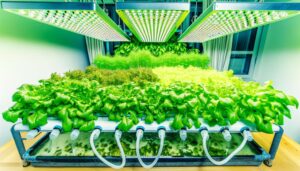What Is a Hydroponic Strawberry
A hydroponic strawberry is a strawberry we grow without soil, using a soilless nutrient-rich water solution. We enhance growth by controlling nutrients, pH levels, and light exposure.
This method accelerates the growth cycle, enhances nutrient uptake, and maximizes photosynthetic efficiency. By utilizing vertical farming techniques, we make efficient use of space and can cultivate strawberries year-round, independent of seasons.
Our controlled setup minimizes pests and soil-borne diseases, resulting in cleaner, safer produce. This approach gives us the ability to monitor and adjust nutrient concentrations meticulously, ensuring peak plant health and yield.
Curious about the intricacies of hydroponic systems?
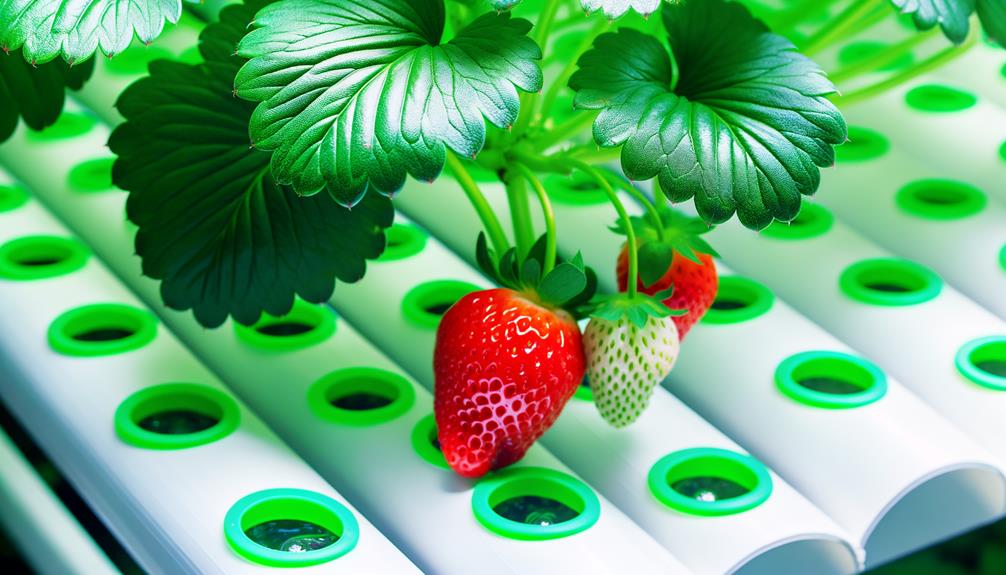
Key Takeaways
- Hydroponic strawberries are grown without soil using a nutrient-rich water solution.
- They benefit from accelerated growth due to optimized nutrient delivery and controlled environments.
- The cultivation method allows for year-round production, independent of seasonal changes.
- Vertical farming techniques maximize space efficiency and productivity, especially in urban settings.
Understanding Hydroponics

Hydroponics, the method of growing plants without soil by using nutrient-rich water solutions, offers a sustainable and efficient alternative to traditional agriculture.
By precisely controlling water, nutrients, and light, we can optimize plant growth and minimize resource wastage.
In hydroponic systems, roots are suspended in a nutrient solution, providing direct access to essential minerals and oxygen.
This method eliminates soil-borne diseases and pests, enhancing plant health.
Utilizing various techniques like nutrient film technique (NFT), deep water culture (DWC), and aeroponics, we can adapt the system to specific plant needs.
Hydroponics also allows for vertical farming, maximizing space.
As we explore hydroponics, understanding its principles lays the foundation for cultivating high-yield, quality crops in controlled environments.
Benefits of Hydroponic Strawberries
Let's explore the advantages of hydroponic strawberries, starting with their accelerated growth rate due to optimized nutrient delivery.
We can also maximize space efficiency through vertical farming techniques.
Additionally, hydroponic systems allow us to produce strawberries without the need for pesticides, resulting in cleaner and safer produce.
Enhanced Growth Speed
By leveraging a soilless nutrient delivery system, we can substantially accelerate the growth cycle of strawberries, leading to quicker harvests and increased yield efficiency.
In hydroponic systems, precise control over nutrient concentration, pH levels, and root zone oxygenation optimizes plant health and growth rates.
Faster growth cycles are achieved through:
- Enhanced nutrient uptake: Direct delivery of essential minerals promotes rapid development.
- Optimal environmental conditions: Consistent temperature and humidity levels prevent growth-limiting stress.
- Reduced disease risk: Absence of soil-borne pathogens minimizes plant infections.
- Efficient water use: Recirculating systems minimize water waste, directing more resources to growth.
These advantages collectively enable us to produce strawberries at an accelerated pace, meeting market demands more efficiently.
Space-Saving Cultivation
In hydroponic strawberry cultivation, vertical farming techniques allow us to maximize space efficiency, enabling higher yield per square meter compared to traditional soil-based methods.
By utilizing tiered systems, we can cultivate multiple layers of strawberries in a controlled environment. This spatial optimization reduces land use and enhances productivity, making it ideal for urban agriculture where space is at a premium.
Additionally, we employ nutrient film technique (NFT) and aeroponics, which deliver precise nutrient solutions to the root zone, ensuring peak growth conditions.
These methods minimize water usage and eliminate the need for soil, further conserving resources.
The compact setup also facilitates easier access for maintenance and harvesting, streamlining operations and reducing labor costs.
Pesticide-Free Produce
How do hydroponic systems guarantee that our strawberries remain pesticide-free while maintaining perfect growth conditions?
By leveraging controlled environments, these systems enable us to mitigate common pest issues without chemical interventions. We utilize sterile growing media, nutrient solutions, and precise climate control to create ideal conditions for strawberry growth. This method reduces pathogen exposure and promotes healthier plants.
Key benefits include:
- Eliminated soil-borne pests: No soil means fewer pests and diseases.
- Controlled nutrient delivery: Guarantees plants get exactly what they need.
- Reduced water usage: Hydroponics uses up to 90% less water than traditional farming.
- Consistent quality: Uniform growing conditions result in consistent produce.
This approach allows us to produce pesticide-free strawberries efficiently and sustainably.
Types of Hydroponic Systems
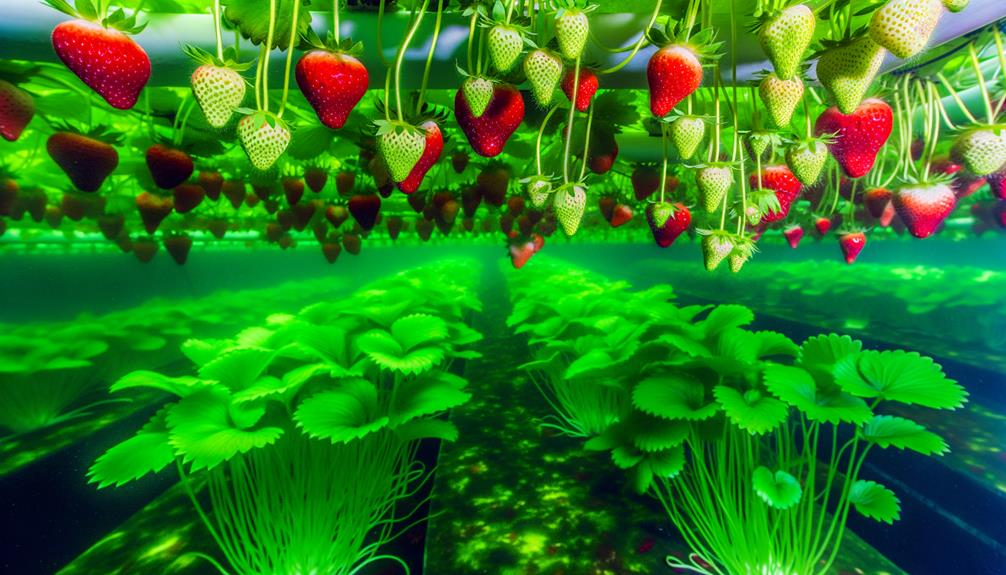
Among the diverse hydroponic systems available, we can distinguish six primary types:
- Nutrient Film Technique (NFT) involves a continuous flow of nutrient solution over the roots, maximizing oxygen exposure.
- Deep Water Culture (DWC) submerges roots in oxygenated nutrient solutions, promoting rapid growth.
- Aeroponics mists roots with nutrient solutions, offering superior oxygenation.
- The Wick System uses capillary action to draw nutrients to plant roots, ideal for low-maintenance setups.
- Ebb and Flow (Flood and Drain) periodically floods the root zone with nutrients, then drains, mimicking natural wet-dry cycles.
- Finally, the Drip System delivers a precise nutrient solution to each plant, ensuring consistent and controlled growth conditions.
Nutrient Solutions
In our hydroponic strawberry systems, nutrient solutions must contain essential macro and micronutrients like nitrogen, potassium, and iron.
We need to maintain ideal pH levels, typically between 5.5 and 6.5, to guarantee nutrient uptake efficiency.
Accurate mixing techniques are vital to achieve balanced nutrient concentrations and prevent deficiencies or toxicities.
Essential Nutrient Components
When cultivating hydroponic strawberries, it's important to formulate a nutrient solution that provides a balanced mix of macro and micronutrients to guarantee ideal plant growth and fruit development. The nutrient solution must include primary macronutrients like nitrogen, phosphorus, and potassium, alongside secondary macronutrients such as calcium, magnesium, and sulfur. Additionally, trace micronutrients are essential for optimal plant health.
Nitrogen (N): Critical for vegetative growth and chlorophyll production.
Phosphorus (P): Key for root development and energy transfer.
Potassium (K): Enhances fruit quality and disease resistance.
Calcium (Ca): Strengthens cell walls, preventing disorders.
Magnesium (Mg): Central component of chlorophyll for photosynthesis.
Optimal Ph Levels
Maintaining ideal pH levels in the nutrient solution is fundamental to ensuring hydroponic strawberries effectively absorb the essential macro and micronutrients. We must aim for a pH range between 5.5 and 6.5. This acidic environment optimizes nutrient solubility and uptake, particularly for elements like iron, manganese, and phosphorus.
Regular monitoring and adjustments are vital; even minor deviations can lead to nutrient lockout or toxicity. Using a digital pH meter, we can achieve precise readings, allowing us to make immediate corrections with pH-up or pH-down solutions.
Additionally, buffering agents can stabilize the pH, preventing drastic fluctuations. By meticulously controlling pH levels, we maximize plant health, resulting in robust growth and high-quality strawberry yields.
Mixing Techniques
Effective mixing techniques for nutrient solutions are essential to guarantee that hydroponic strawberries receive a consistent and balanced supply of essential nutrients. We need to verify that each component is dissolved thoroughly to prevent nutrient imbalances that can affect plant health.
Some critical techniques include:
- Continuous Agitation: Using air stones or mechanical mixers to keep the solution homogeneous.
- Sequential Addition: Adding nutrients one at a time to avoid chemical reactions that precipitate essential minerals.
- Temperature Control: Maintaining ideal solution temperatures to enhance nutrient solubility and uptake.
- Regular Monitoring: Frequent checks of electrical conductivity (EC) and pH to verify solution stability.
Setting Up Your System
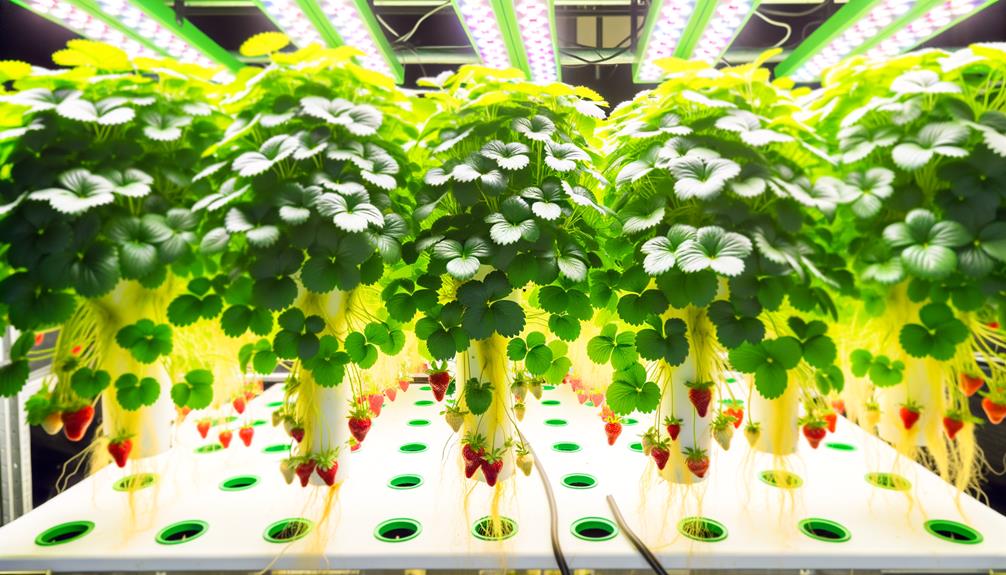
To set up our hydroponic system for strawberries, we'll need to select an appropriate growing medium, guarantee proper nutrient balance, and establish a reliable water circulation method.
For the growing medium, we should consider options like coconut coir or perlite, which provide excellent aeration and drainage.
Maintaining nutrient balance involves using a hydroponic nutrient solution specifically formulated for strawberries, rich in essential elements like nitrogen, phosphorus, potassium, and trace minerals.
For water circulation, implementing a drip or ebb-and-flow system guarantees consistent moisture and nutrient delivery.
Monitoring pH levels and adjusting with pH up or down solutions is vital for ideal nutrient absorption.
Planting and Care
Once the system is set up, we can proceed by carefully transplanting our strawberry seedlings into the chosen growing medium, guaranteeing each plant's roots are well-covered and secure.
It's vital to monitor several key parameters to enhance growth and yield:
- Nutrient Solution pH: Maintain between 5.5 to 6.5 for ideal nutrient uptake.
- EC (Electrical Conductivity): Keep within 1.5 to 2.5 mS/cm to guarantee adequate nutrient concentration.
- Temperature: Ideal range is 18-24°C (64-75°F) for root zone temperature.
- Light Intensity: Provide 14-16 hours of light daily using full-spectrum LED grow lights.
Common Issues and Solutions
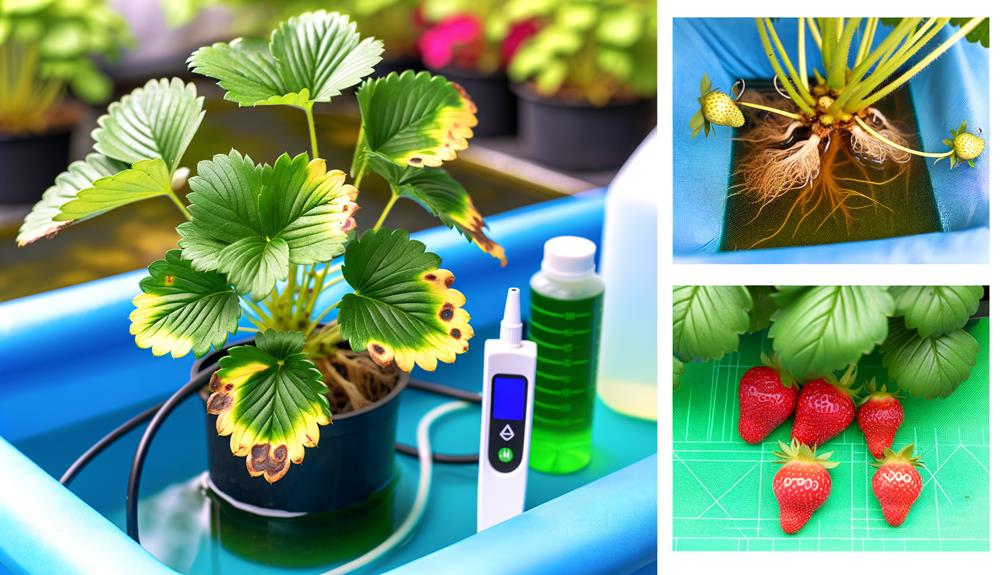
One prevalent issue in hydroponic strawberry cultivation is root rot, often caused by overwatering and poor drainage. To mitigate this, we must monitor the oxygen levels in the nutrient solution carefully. Implementing aeration techniques, such as air stones or oxygenating pumps, can considerably reduce the risk of anaerobic conditions.
Another common problem is nutrient imbalances, which we can address by regularly testing the electrical conductivity (EC) and pH levels of our solution. It's critical to maintain a balanced nutrient profile tailored to strawberries.
Pest infestations, like spider mites and aphids, require vigilant inspection and integrated pest management strategies. Using beneficial insects and organic pesticides can help maintain a healthy, productive hydroponic system.
Harvesting and Enjoying
After addressing common issues in hydroponic strawberry cultivation, we can now focus on the precise timing and techniques for harvesting to guarantee peak fruit quality and flavor. Proper harvesting is critical to maximizing both yield and taste. We should pick strawberries when they're fully red and firm, ensuring ideal sweetness and nutritional value.
Key considerations for harvesting success:
- Timing: Harvest early in the morning to minimize heat stress on the fruit.
- Technique: Use clean, sharp scissors to avoid damaging the plant.
- Frequency: Conduct daily inspections to harvest ripe berries promptly.
- Storage: Store harvested strawberries at 32-36°F to maintain freshness.
Conclusion
To summarize, our exploration of hydroponic strawberries reveals a promising method for sustainable, efficient fruit production.
We've seen that using nutrient-rich solutions and carefully controlled environments can yield superior berries.
By adopting various hydroponic systems, we can mitigate common soil-related issues.
Through our detailed analysis, it's clear that hydroponics isn't just a theory but a viable, scientifically-backed approach to modern agriculture.
Let's continue to refine our techniques and enjoy the fruits of our labor—literally and figuratively.





